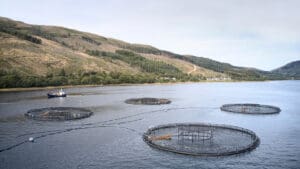
Scottish salmon farming is now adding £1 billion a year to Scotland’s economy, according to a major new independent study that underscores the sector’s growing importance to rural communities, the national supply chain and Scotland’s global reputation for high-quality food production.
The report, produced by BiGGAR Economics for Salmon Scotland, reveals that the industry’s overall economic contribution has risen by 25 per cent in four years, reflecting both sustained domestic demand and record-breaking international exports. It describes salmon farming as one of Scotland’s most significant rural economic drivers, supporting 11,000 jobs nationwide, including around 2,500 people directly employed in farming across the west coast and islands.
Average salaries in the sector are now around £44,500, significantly above the Scottish average, and the industry generated at least £37 million in tax last year before wider supply chain contributions are taken into account. Analysts say salmon farming continues to play a vital role in some of the country’s most economically fragile communities, underpinning year-round employment and attracting investment into remote coastal areas.
Deputy First Minister Kate Forbes, who met sector leaders in Edinburgh this week, said the findings highlight not just a major economic contribution but the “resilience, innovation and commitment” of those working in the industry. She praised the sector for paying above-average wages, strengthening supply chains and supporting rural communities, adding that the Scottish Government will “continue to take bold steps” to ensure it remains a national success story.
The report shows that salmon farming contributed £231.2 million in Gross Value Added directly in 2024, while a further £589.9 million was generated through businesses supplying the sector. Additional impact came from sustained investment activity and spending by employees in local communities, bringing the total economic contribution to £953 million—up sharply from £766 million in 2021. When broader impact measures are included, the industry’s annual value rises to more than £1 billion.
Tavish Scott, chief executive of Salmon Scotland, said the industry’s continued growth reflects the hard work of farmers across Scotland’s west coast and islands, where salmon farming remains a central pillar of local economies. He said farm-raised salmon is “the economic backbone of some of Scotland’s most isolated areas”, supporting thousands of well-paid jobs and a network of Scottish businesses that rely on its success. Scott added that the sector’s high environmental and welfare standards, combined with strong global demand, have helped to position Scottish salmon as one of the world’s leading premium food products.
The economic impact is widely felt across Scotland’s five salmon-producing regions. The Highlands benefit the most, with more than £300 million generated locally, followed by Argyll and Bute, Shetland, the Western Isles, and Orkney, each of which receives significant economic uplift from salmon-related jobs, investment and supply chain activity.
Nikki Keddie, director at BiGGAR Economics, said the report shows how salmon farming provides stability and opportunity in communities that may otherwise struggle to sustain long-term employment. She described the sector as a “vital economic anchor” for rural Scotland, noting that productivity levels in salmon farming outpace national averages and play a major role in supporting Scotland’s coastal resilience.
With rising demand, expanding export markets and continued investment in innovation, the Scottish salmon sector looks set to remain a cornerstone of the national economy, supporting jobs, strengthening supply chains and sustaining communities across Scotland’s west coast and islands.
Read more:
Scottish salmon delivers £1bn boost to economy as new report reveals soaring impact
